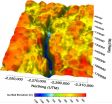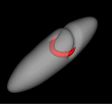(Press-News.org) The greens and blues of the ocean color from NASA satellite data have provided new insights into how climate and ecosystem processes affect the growth cycles of phytoplankton—microscopic aquatic plants important for fish populations and Earth's carbon cycle.
At the bottom of the ocean's food chain, phytoplankton account for roughly half of the net photosynthesis on Earth. Their photosynthesis consumes carbon dioxide and plays a key role in transferring carbon from the atmosphere to the ocean. Unlike the plant ecosystems on land, the amount of phytoplankton in the ocean is always followed closely by the abundance of organisms that eat phytoplankton, creating a perpetual dance between predators and prey. This new analysis shows how tiny imbalances in this predator-prey relationship, caused by environmental variability, give rise to massive phytoplankton blooms, having huge impacts on ocean productivity, fisheries and carbon cycling. The study was released Thursday, Sept. 25, in the journal Nature Climate Change.
"The continuous year-in and year-out measurements provided by NASA's ocean color satellites have dramatically changed our understanding of phytoplankton dynamics on the Earth," said Mike Behrenfeld, author of the study and phytoplankton ecologist at Oregon State University, Corvallis, Oregon. "What we now see is a closely linked system of phytoplankton cell division and consumption lying at the heart of the plant's annual cycle."
Behrenfeld calls this close predator-prey relationship the "Dance of the Plankton." This view is different from previous perspectives that have simply focused on environmental resources used by phytoplankton to grow, such as nutrients and light. The new view is important because it reveals that tiny imbalances can greatly impact Earth's ecology.
Over the past few years, Behrenfeld has collaborated with Emmanuel Boss at the University of Maine, Orono; David Siegel at the University of California, Santa Barbara; and Scott Doney at Woods Hole Oceanographic Institute, Woods Hole, Massachusetts, to develop a new theoretical framework for explaining phytoplankton blooms, which they call the "Disturbance-Recovery Hypothesis." According to this view, blooms can be started by any process that disturbs the natural balance between phytoplankton and their predators.
A disturbance may involve deep mixing of the surface ocean by storms, bringing up deep ocean water along coasts (known as coastal upwelling), a river flowing into the ocean or even an intentional disturbance such as fertilizing ocean ecosystems with iron. The new study is focused on the second part of the hypothesis – how plankton ecosystems recover once they have been disturbed.
Behrenfeld explained that in ocean ecosystems, the activities of the phytoplankton are closely followed by the organisms that consume phytoplankton, in a sense, similar to two balls connected by a rubber band. If one ball is hit with a paddle, it will accelerate ahead of the other ball. Once the lead ball starts to slow down, the other ball will catch it, even if the lead ball is still moving forward.
"Basically, phytoplankton are rubber-banded to their predators," Behrenfeld said. "As long as the phytoplankton are accelerating in their division rate, they'll stay ahead. As soon as they slow down, the predators that have been increasing along with the phytoplankton will quickly catch up, stop the bloom by consuming the phytoplankton, and then begin decreasing the numbers of phytoplankton."
Using data from NASA's Moderate Resolution Imaging Spectrometer (MODIS), Behrenfeld shows how tight predator-prey relationships are a common feature of plankton ecosystems across the global ocean. Even in regions where phytoplankton blooms do occur, they result from only minor imbalances in this relationship. By focusing on the North Atlantic Ocean, where one of the largest phytoplankton blooms happens each year, the study shows how deeper winter mixing gives rise to larger phytoplankton stocks. This finding is important because it suggests that ocean warming over the coming century, which will decrease winter mixing, may significantly decrease peak phytoplankton stocks.
Behrenfeld also tracked the annual cycles of phytoplankton over a 10-year period in the North Atlantic using data from NASA's Sea-viewing Wide Field-of-view Sensor (SeaWiFS). He showed for the first time how changes in phytoplankton populations over time are governed by periods of accelerating and decelerating division rates. This discovery finally connects the start of a phytoplankton bloom to its final climax, which may occur many months later.
"Understanding the plankton ecosystem and how it responds to variability is very important for preparing and looking forward to how Earth's system changes," said Behrenfeld. "The environmental conditions that start and then sustain phytoplankton blooms are, in many cases, the same environmental factors that are impacted by climate change."
The next steps are to understand how species succession impacts bloom development and to learn how the carbon dioxide taken up by phytoplankton is processed within plankton ecosystems and then transferred and stored in the deep ocean. These advances are critical for understanding how changes in phytoplankton blooms translate to impacts on fisheries and climate. These challenging goals will require a greater integration of satellite, modeling and field studies.
"Current satellites, such as Terra and Aqua, monitor changes in phytoplankton abundance that continuously occur across the globe," said Behrenfeld. These changes reflect complex biological and physical interactions within ocean ecosystems. Understanding how these interactions function in today's ocean is essential to predicting how marine ecosystems will change in the future." Future missions, such as the Pre-Aerosol, Clouds, and ocean Ecosystem (PACE) mission, will further elucidate the plankton dynamics and responses to climatic shifts in the ocean.
INFORMATION:
NASA ocean data shows 'climate dance' of plankton
2014-09-30
ELSE PRESS RELEASES FROM THIS DATE:
NASA support key to glacier mapping efforts
2014-09-30
Thanks in part to support from NASA and the National Science Foundation, scientists have produced the first-ever detailed maps of bedrock beneath glaciers in Greenland and Antarctica. This new data will help researchers better project future changes to glaciers and ice sheets, and ultimately, sea level.
Researchers at the Center for Remote Sensing of Ice Sheets, or CReSIS, at the University of Kansas in Lawrence, Kansas, recently built detailed maps of the terrain beneath Greenland's Jakobshavn Glacier and Byrd Glacier in Antarctica. The results of this study were published ...
NASA-funded rocket has 6 minutes to study solar heating
2014-09-30
On Sept. 30, 2014, a sounding rocket will fly up into the sky – past Earth's atmosphere that obscures certain wavelengths of light from the sun -- for a 15-minute journey to study what heats up the sun's atmosphere. This is the fourth flight for the Very high Angular Resolution Ultraviolet Telescope, or VAULT, will launch from the White Sands Missile Range near Las Cruces, New Mexico.
The instrument, now called VAULT2.0, has been refurbished with new electronics and an imaging detector to capture images more frequently than before. While in space, VAULT2.0 will observe ...
Deceptive-looking vortex line in superfluid led to twice-mistaken identity
2014-09-30
So long, solitons: University of Chicago physicists have shown that a group of scientists were incorrect when they concluded that a mysterious effect found in superfluids indicated the presence of solitons—exotic, solitary waves. Instead, they explain, the result was due to more pedestrian, whirlpool-like structures in the fluid. They published their explanation in the Sept. 19 issue of Physical Review Letters.
The debate began in July 2013, when a group of scientists from the Massachusetts Institute of Technology published results in Nature showing a long-lived structure ...
New discovery approach accelerates identification of potential cancer treatments
2014-09-30
ANN ARBOR—Researchers at the University of Michigan have described a new approach to discovering potential cancer treatments that requires a fraction of the time needed for more traditional methods.
They used the platform to identify a novel antibody that is undergoing further investigation as a potential treatment for breast, ovarian and other cancers.
In research published online in the Proceedings of the National Academy of Sciences, researchers in the lab of Stephen Weiss at the U-M Life Sciences Institute detail an approach that replicates the native environment ...
Gene doubling shapes the world: Instant speciation, biodiversity, and the root of our existence
2014-09-30
What do seedless watermelon, salmon, and strawberries all have in common? Unlike most eukaryotic multicellular organisms that have two sets of chromosomes and are diploid, these organisms are all polyploid, meaning they have three or more sets of chromosomes—seedless watermelon and salmon have 3 and 4 sets of chromosomes, respectively, and strawberries have 10! While this might seem surprising, in fact most plant species are polyploid. Polyploidy, or genome doubling, was first discovered over a century ago, but only recently, with the development of molecular tools, has ...
Smithsonian scientists discover coral's best defender against an army of sea stars
2014-09-30
Coral reefs face a suite of perilous threats in today's ocean. From overfishing and pollution to coastal development and climate change, fragile coral ecosystems are disappearing at unprecedented rates around the world. Despite this trend, some species of corals surrounding the island of Moorea in French Polynesia have a natural protector in their tropical environment: coral guard-crabs. New research from the National Museum of Natural History's Smithsonian Marine Station scientist Seabird McKeon and the museum's predoctoral fellow Jenna Moore of the Florida Museum of Natural ...
Asthma symptoms kicking up? Check your exposure to air pollution
2014-09-30
ARLINGTON HEIGHTS, Ill. (September 30, 2014) – People who suffer from asthma may think there's not a lot they can do to control their asthma besides properly taking medications and avoiding allergic triggers.
According to a new article in the Annals of Allergy, Asthma and Immunology, the scientific publication of the American College of Allergy, Asthma and Immunology (ACAAI), asthma sufferers can learn lessons about managing their asthma by examining their lifestyle. The woman described in the Annals article improved her asthma once she and her doctor determined her ...
High-dose vitamin D for ICU patients who are vitamin D deficient does not improve outcomes
2014-09-30
Administration of high-dose vitamin D3 compared with placebo did not reduce hospital length of stay, intensive care unit (ICU) length of stay, hospital mortality, or the risk of death at 6 months among patients with vitamin D deficiency who were critically ill, according to a study published in JAMA. The study is being posted early online to coincide with its presentation at the European Society of Intensive Care Medicine annual congress.
A high prevalence of low vitamin D levels has been confirmed in patients who are critically ill. Many studies suggest that a low vitamin ...
Gut bacteria promote obesity in mice
2014-09-30
A species of gut bacteria called Clostridium ramosum, coupled with a high-fat diet, may cause animals to gain weight. The work is published this week in mBio®, the online open-access journal of the American Society for Microbiology.
A research team from the German Institute of Human Nutrition Potsdam-Rehbruecke in Nuthetal observed that mice harboring human gut bacteria including C. ramosum gained weight when fed a high-fat diet. Mice that did not have C. ramosum were less obese even when consuming a high-fat diet, and mice that had C. ramosum but consumed a low-fat ...
Endoscopists recommend frequent colonoscopies, leading to its overuse
2014-09-30
Boston, MA – A retrospective study led by researchers at Brigham and Women's Hospital (BWH), has found an overuse of colonoscopies for colorectal cancer screening and surveillance. The study demonstrated that endoscopists commonly recommended shorter follow-up intervals than established guidelines support, and these recommendations were strongly correlated with subsequent colonoscopy overuse.
"Our study shows that a high percentage of follow-up colonoscopies are being performed too early, resulting in use of scarce health care resources with potentially limited clinical ...



